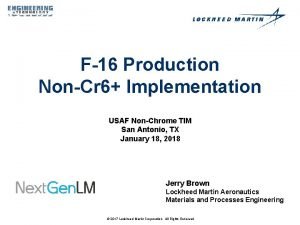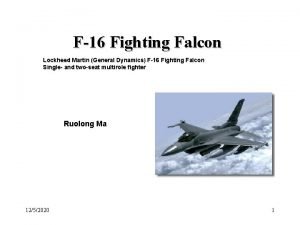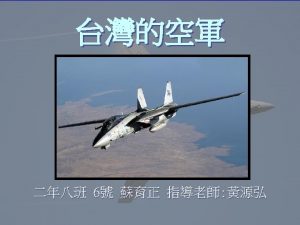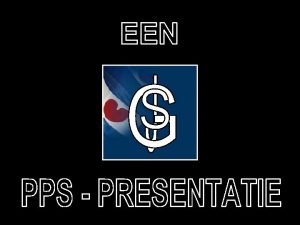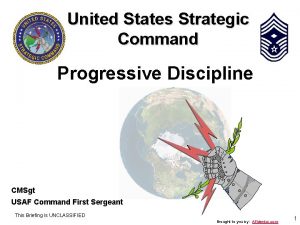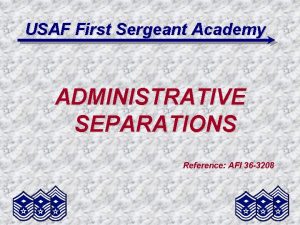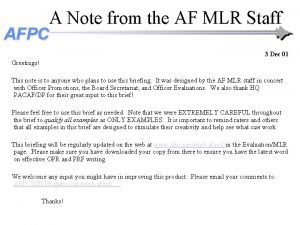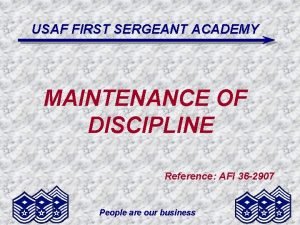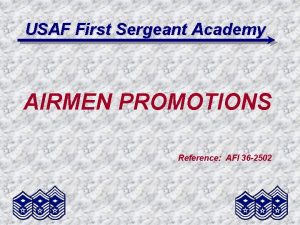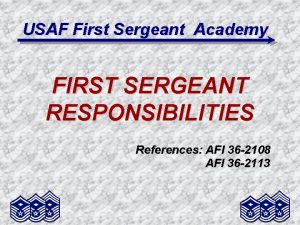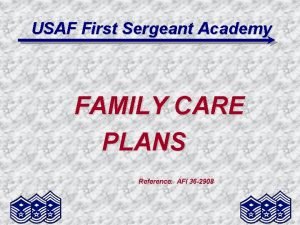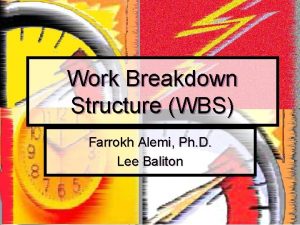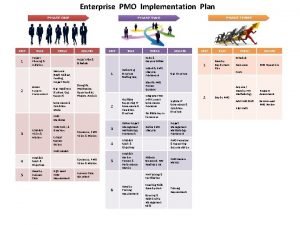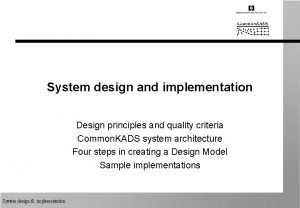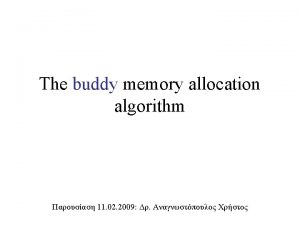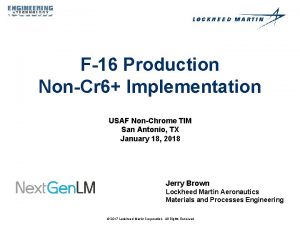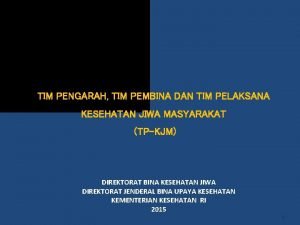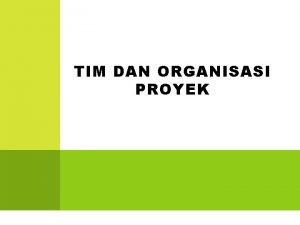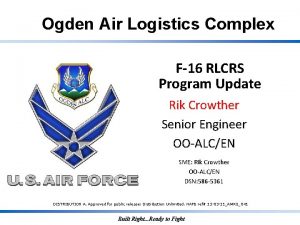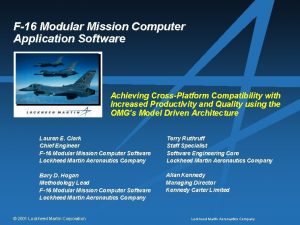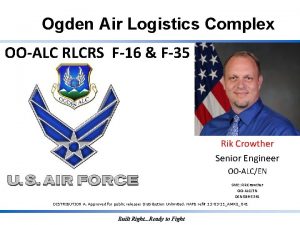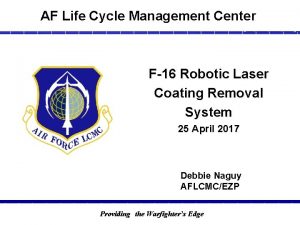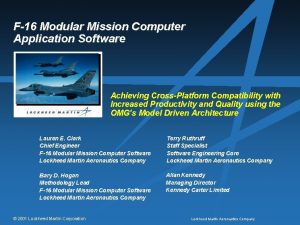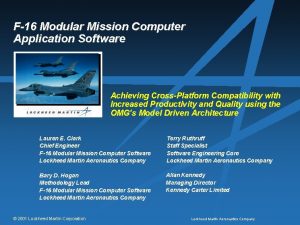F16 Production NonCr 6 Implementation USAF NonChrome TIM















- Slides: 15

F-16 Production Non-Cr 6+ Implementation USAF Non-Chrome TIM San Antonio, TX January 18, 2018 Jerry Brown Lockheed Martin Aeronautics Materials and Processes Engineering © 2017 Lockheed Martin Corporation. All Rights Reserved

F-16 Production Non-Cr 6+ Implementation • The F-16 Production Program has been working to eliminate hexavalent chromium for nearly 30 years – Lab tests and flight tests of first generation non-chrome primers in the 1990 s • Flight test – Two non-chrome primers applied over chromated chemical conversion material on wings of four aircraft (Spraylat EWDY 048, Dexter Crown Metro 10 PW 22 -2) – Underlying anodize still present to some extent • Over six year period, finish system performed reasonably well with no major finish system failures – Typical finish repairs for in-service aircraft • Overall performance not deemed satisfactory for production implementation – Lab results of non-chrome primers not as good as legacy chrome primers – Concerns about ongoing dependability of new non-chrome primer products – Difficulty in limiting non-chrome primer to OML surfaces in production processes © 2017 Lockheed Martin Corporation. All Rights Reserved 2

F-16 Production Non-Cr 6+ Implementation • The work continued in the 2007 time frame with testing of the nextgeneration non-chrome primers – Lab testing performed on Deft (44 -GN-098, 02 -GN-084, 02 -GN-093), Hentzen (16708 TEP, 17035 GEP), Akzo Nobel (Mg. Rich) • Exterior program – Adhesion, flexibility, corrosion tests per MIL-specs – Multiple finish stackups for F-16 OML • Interior program – Adhesion tests • Multiple substrates such as 6000 series Al, 7000 series Al, Al casting, Ti, CRES, cad-plated alloy steel – Fluid resistance tests • Carried out three times longer than MIL-spec requirements using water, lubricating oil, hydraulic fluid) – Galvanic tests (specimens put in neutral salt spray) • Alloy steel fasteners in primed and topcoated 2000 series Al panel, scribed across fastener heads) • Titanium panel attached to primed and scribed 2000 series Al panel (using Ti fasteners) © 2017 Lockheed Martin Corporation. All Rights Reserved 3

Corrosion Test Examples from Exterior Program © 2017 Lockheed Martin Corporation. All Rights Reserved 4

Galvanic Test Examples from Interior Program © 2017 Lockheed Martin Corporation. All Rights Reserved 5

Galvanic Test Examples from Interior Program © 2017 Lockheed Martin Corporation. All Rights Reserved 6

Galvanic Test Examples from Interior Program © 2017 Lockheed Martin Corporation. All Rights Reserved 7

Galvanic Test Examples from Interior Program © 2017 Lockheed Martin Corporation. All Rights Reserved 8

F-16 Production Non-Cr 6+ Implementation • These programs resulted in qualification of three non-chrome primers to the F-16 internal QPLs for primers – 44 -GN-098 placed on FQML-P-85582 for MIL-PRF-85582 – 02 -GN-084, 16708 TEP placed on FQML-P-23377 for MIL-PRF-23377 – 02 -GN-093 left off due to its lack of NAVAIR qualification to MIL-PRF-23377 • 44 -GN-098 implemented first quarter 2016 at LM Aero in Fort Worth – For both exterior and interior base priming applications on F-16 components – Anodize (with hex chrome seal) or hex chrome chemical conversion material still required as pretreatment for aluminum substrates • Previous and ongoing testing at LM Aero for non-Cr 6+ anodize seal and chemical conversion material has not achieved results adequate for implementation at LM in Fort Worth – 44 -GN-098 chosen because of its previous implementation on the F-35 program • Painters already experienced in its application © 2017 Lockheed Martin Corporation. All Rights Reserved 9

F-16 Production Non-Cr 6+ Implementation • So…we have made progress! • But…we still have hexavalent chromium in the finish systems on the aircraft! – Anodize and anodize seal • LM uses thin film sulfuric acid anodize at Fort Worth, but chromic acid anodize still allowed for subcontractors – Chemical conversion material – Fuel tank coating – Fast drying touchup primer – Specialty intermediate primer • Achieving total non-Cr 6+ implementation on production aircraft presents some unique challenges – These challenges may also have applicability to mod programs at depot locations and some organization- and commodity-level work required by Tech Orders © 2017 Lockheed Martin Corporation. All Rights Reserved 10

Material Replacement Challenges in Production • Application Challenges – F-16 has hundreds of finish codes for all of the different finish applications on both the exterior and interior areas of the aircraft • Different base substrates • Different pretreatments/surface preparation • Galvanic situations • Primer only areas (e. g. some interior bays) • Pretreatment only areas (e. g. electrical ground areas) • Specialty coatings (e. g. fuel tanks) • Specialty coatings (e. g. cockpit) – Many of these internal areas are not visually seen after aircraft assembly unless a problem arises • Engineering is hesitant to remove all hexavalent chromium in these situations – Some non-Cr 6+ primers may not be as robust adhering to multiple substrates – Some non-Cr 6+ primers do not hold up well unless topcoated – Pretreatment only areas are a great concern! © 2017 Lockheed Martin Corporation. All Rights Reserved 11

Material Replacement Challenges in Production • Production Process Challenges – Manufacturing processes involving detail parts do not always lend themselves to comprehensive material replacements • Some parts are partially finished at one time and completed at a much later time – Manufacturing process delays topcoating of some parts until next assembly – e. g. many aluminum parts are pretreated and primed, then put on a shelf until ready to use • • Finish system must be able to hold up to storage and be capable of reactivation Some production facilities are used for multiple programs – All programs must agree on the material replacement change at the same time – e. g. chem processing lines such as anodize and chemical conversion • All surfaces of specific detail parts are typically finished at the same time – Multiple finishes on detail parts would create a more expensive and complex production process – Non-Cr 6+ materials used on external surfaces of fuselage skin must be suitable for use as interior coatings as well © 2017 Lockheed Martin Corporation. All Rights Reserved 12

Material Replacement Challenges in Production • Specification Challenges – The F-16 finish system is based upon separate material specifications for different components of the finish system • Anodize must meet internal LM specification or MIL-A-8625 • Chemical conversion material must meet MIL-DTL-81706 • Primers must meet MIL-PRF-23377 or MIL-PRF-85582 • Fuel tank coating must meet AMS-C-27725 – Materials are purchased to these specifications and put together to achieve the finish system goals – There is currently no total finish system specification that provides the necessary requirements for production finish operations • e. g. MIL-PRF-32239 is intended for exterior aircraft refinishing operations • Complexity of production finish systems cannot be addressed by a “one size fits all” finish approach – This speaks to the necessity of the finish code system to satisfy all requirements for the many substrates and applications © 2017 Lockheed Martin Corporation. All Rights Reserved 13

Going Forward • Production programs will continue to work individual finish systems that utilize hexavalent chromium to determine if material replacements are satisfactory – Testing (laboratory and beach) – Shop trials – Document development/changes – Implementation • Plan to stay involved in industry discussions on hexavalent chromium replacements – Chrome elimination working groups – Environmental working groups – Continual contact with supplier base • Progress will continue to be made in identifying non-Cr 6+ material replacements that will satisfy the technical requirements for corrosion protection and aircraft performance © 2017 Lockheed Martin Corporation. All Rights Reserved 14

 Noncr
Noncr Alir proses produksi produk multimedia
Alir proses produksi produk multimedia Sfw f16
Sfw f16 F16 net
F16 net F16 mc
F16 mc Air force progressive discipline chart
Air force progressive discipline chart Usaf first sergeant afi
Usaf first sergeant afi Usaf 2 line prf examples
Usaf 2 line prf examples Progressive discipline air force
Progressive discipline air force Promotions afi
Promotions afi Usaf first sergeant afi
Usaf first sergeant afi Afi 36-2908
Afi 36-2908 Ehr implementation work breakdown structure
Ehr implementation work breakdown structure How to create a pmo implementation plan
How to create a pmo implementation plan Implementation design principles
Implementation design principles Buddy memory allocation implementation
Buddy memory allocation implementation
